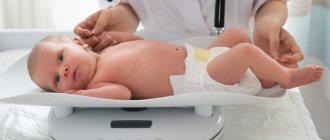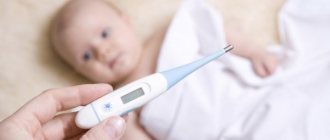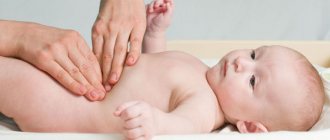Body temperature is an indicator of a person's health status. We are so accustomed to thinking that the norm is 36.6° that any deviations from this figure throw us off balance. Especially when it comes to fever in children, because a baby who cannot speak cannot tell what is happening to him. That is why correct temperature measurement and correct interpretation of the results helps parents understand whether to sound the alarm. Today we are talking with pediatrician Polina Aleksandrovna Kizino about how to correctly measure temperature in children and what the “temperature norm” is.
Methods for measuring temperature in infants
There are several ways to measure the temperature of a newborn. Parents should choose the most appropriate method according to the situation and age of the baby.
Rectal
Despite the fact that this method gives the most accurate results, pediatricians do not recommend using it very often in young children. If parents decide to use this method, then they should do everything according to the rules. It is important to place the thermometer in the anus very carefully, especially if it is glass. First, it should be warmed to room temperature, the tip should be lubricated with Vaseline or massage oil. You should not use baby cream, as it often causes tingling and the baby will behave restlessly.
How to measure the temperature of newborn babies rectally:
- The baby needs to be placed on his back, the legs bent at the knees slightly raised and the thermometer very carefully inserted into the anus;
- The depth of immersion of the thermometer should not be more than 1.5-2 cm;
- The duration of the procedure is 5-7 minutes;
- Next, the thermometer should be very carefully removed, look at the result and washed with soap, preparing for further use.
Note! If the baby cries a lot and arches his back all the time, then you should not continue the procedure, since there is a high probability that the thermometer will break while in the baby’s bottom.
Rectal measurement
Oral
You can also measure the temperature orally; to do this, you need to place the thermometer in the baby’s mouth. This will not be easy to do, since the baby will immediately begin to bite the thermometer or push it out of his mouth. The best solution is to use a pacifier thermometer. It needs to be inserted into the baby’s mouth and held until the result appears. This option is the most convenient, since the child will not have to stay in a not very comfortable position for a certain time. This method is only suitable for those children who are accustomed to a pacifier, otherwise the child will simply spit it out on the floor.
Oral measurement method
Axillary
Measuring body temperature under the armpit is the simplest and most common of all methods. It is important for parents to remember that this method should be used very carefully. Before placing the thermometer, you need to make sure that the child’s skin is clean and dry. With the axillary method, the result obtained should not exceed 37.5 °C; if the temperature is higher, this means that pathological changes are occurring in the baby’s body.
Important! It is necessary to take your temperature every day at the same time. It is better to write down the readings in a separate notebook. The result that is considered normal is the average value of all previously taken measurements.
Tympanic
How to measure a baby's ear temperature using an electronic thermometer:
- Take the child by the earlobe and lightly pull it back and slightly up;
- When the ear canal straightens and the eardrum is visible, you must very carefully insert the sensor into the baby's ear;
- The thermometer must be removed very slowly and carefully so as not to damage the child's hearing aid.
Tympanic measurement
Palpation
Before measuring body temperature without using a thermometer, parents need to make sure their hands are warm. Otherwise, the measurement result will be inaccurate. For this method of measurement, mom or dad should place the back of their hand on the child’s forehead, in the inguinal folds, on the back of the head, neck or armpit and wait 2-3 minutes. If the local temperature in these places is elevated and the skin is moist, this will mean that the baby has a fever caused by pathological processes in the body. As a rule, children perceive this method of measuring temperature quite calmly.
If you detect an elevated temperature, you should use a thermometer to understand how much the temperature has risen and whether it needs to be brought down.
Important! Signs of a fever in your baby are also very cold hands and feet. It should be noted that this sign will only be valid when the baby is feeling unwell, and not when he is simply cold.
Contactless
An infrared thermometer is a new device that will help you determine your baby’s body temperature in a matter of seconds, without even touching it. In order for a non-contact thermometer to always show accurate results, it is important to understand how best to measure the temperature of a newborn baby with its help.
Parents should adhere to certain rules:
- Eliminate extraneous air flow (fan, air conditioner, heater);
- Make sure that the baby has a clean forehead, without cream;
- If the baby is sweating, wipe his forehead with a napkin;
- Wipe the thermometer sensor with a soft cloth to remove dust;
- Hold the child in your arms so that he does not move or cry during the measurement;
- Next, click on the “Start” or “Measurement” button;
- Bring the device to the baby’s forehead at a distance of 4-6 cm;
- Wait for a loud sound signal and blinking diodes;
- View the result.
Non-contact method
How to avoid mistakes when taking thermometry
Instructions are included with each thermometer. It should be studied and definitely followed. This will help minimize value errors.
You should also take into account some nuances:
- In a newborn, the temperature often rises from any active action.
You should not measure the temperature immediately after bathing your baby, massage or gymnastics, or eating. The most accurate indicators can be obtained while the baby is sleeping;
- You should make sure that there are no diaper rashes in the folds of the skin, inflammatory processes and pustules on the mucous membranes (with the rectal and oral route).
- The baby's skin in the measurement area should be dry (sweat cools the thermometer).
- The thermometer should not be cold.
- A negative reaction of the baby to the procedure (crying, arching of the back) is a signal to stop it. In this case, it will still not be possible to get an accurate temperature reading; it is better to calm the baby down and try again.
With certain skills, measuring the temperature of a newborn baby will not be difficult. When purchasing a thermometer, you should consider safety and convenience for the baby. The measurement method is chosen depending on the activity and physical condition of the baby, the severity of the disease in a particular period.
Normal body temperature for infants
Normal body temperature in a newborn is 36.2-37.5 °C. The result of the measurements obtained will depend on the method in which they were made. The temperature of an infant under six months of age is considered normal if it does not exceed 37.5°C. It should also be taken into account that the lowest temperature will be obtained when measuring it in the armpit; with the oral method it will be higher by 0.5 ° C, and in the rectum - by a whole degree.
Normal temperature in a baby
It is important for parents to know that:
- After a night's sleep, a child's temperature very rarely rises to 37 °C;
- When a child goes to bed, at this time his temperature drops slightly;
- During feedings, the baby works and tries very hard, as everyone knows, during any work you can observe an increase in temperature;
- Do not be alarmed if your newborn baby has a slight fever; perhaps he is dressed too warmly. You need to remove excess clothing and measure your temperature after twenty minutes;
- When the temperature drops below 36.2 °C, the baby is hypothermic and needs to be wrapped up.
- During a massage or gymnastics, body temperature may rise to 38 °C, but there is no need to panic, you should let the baby rest and repeat the measurements.
Values for different measuring methods
Thermoregulation processes in infants begin to develop before one year of age. During this period of life in a small organism, large temperature fluctuations are possible - from 36 ° C to 37.7 ° C. Such indicators are considered normal if the child is active, has a good appetite, sleeps soundly, and nothing hurts. It is also quite normal if the temperature rises to 37.7 °C with prolonged screaming, very strong straining with constipation, and active games.
The thermometer readings will depend on how the temperature is measured:
- In the armpit or in the groin fold the average reading will be in the range of 36.3-37.3°C.
- In the mouth (with the oral method of measurement) the indicator should be within 37.1°C.
- In the anus or between the buttocks (rectal measurement method), values can vary from 37.6°C to 38°C.
- In the ear (tympanic method), the norm is considered to be 31.3°C.
The indicated indicators are obtained only if the measurements were carried out according to all the rules. Exceeding the specified values by 0.5°C is considered a pathology.
Note! It is better to measure a baby's temperature when he is in a relaxed state, for example, half an hour after a meal or an hour after a warm bath. If the baby is capricious and crying, then this procedure should be postponed for a while.
How to measure the temperature if you don’t have a thermometer at hand?
An unhealthy bright blush and redness of the skin may be the first symptoms of an increase in body temperature. Some mothers use the folk method: they touch the baby’s forehead with their lips or the back of the hand to the popliteal area.
An increase in temperature can be determined by a number of external signs:
- Increased sweating.
- Cardiopalmus.
Normally, a baby's heart rate is 100 beats in 60 seconds. An approximate temperature indicator can be calculated as follows: subtract 100 from the current pulse value, divide the difference by 10. Add 36.6 to the resulting number (average rate). Let’s say a newborn’s pulse is 120 beats: (120 – 100): 10 + 36.6 = 38.6º C;
- Rapid breathing.
- Dehydration.
Characterized by dry skin and oral mucosa, increased viscosity of saliva, retraction of the fontanelles on the head;
- Lethargy, drowsiness, or constant crying.
- The appearance of seizures means an increase in temperature to 39º C, requiring immediate action to reduce the fever.
Types of thermometers for measuring temperature
Should I give water to my baby or not?
There is a huge selection of different thermometers; parents should decide which one is best to purchase. It is important to decide which device will be the most optimal for measuring the temperature of a baby.
Electronic
There are many different electronic thermometers on the market, each of them designed to measure a specific area of the body. There are thermometers for axillary, rectal, and ear measurements. The famous pediatrician Komarovsky states that the thermometer requires close contact with the body; accurate readings can only be achieved with rectal or oral administration. When measuring in the armpit, the indicator may be lower due to the large error.
An electronic thermometer has the following advantages:
- Simple and safe to use;
- The measurement takes no more than three minutes;
- When the measurement is completed, a loud beep sounds.
The disadvantage of an electronic thermometer is low accuracy. The error reaches 1 degree. To increase the veracity of the result, you need to hold it for another minute after the sound signal.
Electronic thermometer
Thermometer in the form of a pacifier
This thermometer has the same shape as a regular pacifier and is another type of digital thermometer. Manufacturers make pacifiers from latex or silicone and equip them with a device that beeps after the measurement is completed.
Advantages of the device:
- Unlike other types of thermometers, it has a shape familiar to the baby;
- The device is made from materials that are safe for health.
This device also has some disadvantages:
- The measurement accuracy is not very high;
- Duration of measurement – 3-5 minutes;
- The shape of the pacifier may differ from that to which the child is accustomed;
- Not suitable for use if the baby is not accustomed to a pacifier;
- The duration of use of such a thermometer is limited by the time when the baby uses the pacifier; after the baby refuses it, the thermometer will no longer be able to be used.
Thermometer in the form of a pacifier
Mercury
Advantages of a mercury thermometer:
- Easy to use, it is very easy for them to determine whether a child has a fever;
- High accuracy;
- Convenient scale indicating the normal temperature limit;
- Low cost.
A mercury thermometer has certain disadvantages:
- It is easy to break or break as it is made of thin glass;
- Contains mercury inside, which is a strong poison;
- You need to know how long to measure. As a rule, this is 7-10 minutes.
Mercury thermometer
Infrared
Thanks to this device, the result can be obtained instantly. An infrared ear thermometer should be inserted into the ear, and a non-contact thermometer should just be brought to the forehead or temple. This is convenient if the baby is a newborn or one month old.
Advantages of this thermometer:
- Safety of use;
- Easy to use.
The disadvantages are the high cost and error in readings.
Infrared thermometer
Review of popular thermometers
Let's consider the characteristics of electronic models for measuring temperature:
| Name | pros | Minuses | Addition |
| B.Well WT-03 Family | 1. Change accuracy 2. Waterproof housing 3. Convenient display 4. Auto shutdown 5. Memory | High price | Manufactured by the Swiss company B.Well |
| AND DT-501 | 1. Replaceable battery 2. Memory 3. Auto power off 4. Waterproof housing 5. Rectal and oral measurement speed - minute | 1. No backlight 2. Small error | The disadvantages are compensated by the low cost of the gadget |
| Thermal Standard | 1. Measurement accuracy 2. Replaceable battery 3. Memory 4. Auto power off 5. Sound signal 6. Measurement speed | 1. Quiet beep 2. No display backlight | The low price compensates for some of the device's shortcomings |
| Omron Eco Temp Basic | 1. Simplicity of the device 2. Sound signal 3. Low price | 1. Large error 2. No backlight 3. Small display 4. Sealed battery | Budget model for the whole family |
| Little Doctor LD-300 | 1. Measuring speed 2. Waterproof housing 3. Replaceable battery 4. Memory 5. Convenient display | 1. Error in readings | The verification measurement must be carried out on the same area of the body, at the same angle of inclination and for the same time. |
Infrared models, comparison:
| Name | pros | Minuses | Addition |
| Xiaomi iHealth Meter Thermometer | 1. Measurement speed 2. Minimum error 3. Distance sensor 4. Backlight 5. Vibration sound signal 6. Multifunctionality 7. Auto shutdown | High price | A universal device for determining the temperature of body, liquid, air |
| Medisana TM 750 | 1. Speed of operation 2. Replaceable battery 3. Backlight 4. Temperature of objects 5. Memory 30 cells 6. Compact body | 1. Contact device 2. Error 3. Complex instructions | The time and date of measurements are stored in memory |
| Sensitec NF-3101 | 1. Non-contact 2. Minimum error 3. Backlight 4. Large memory 5. Replaceable batteries | 1. Does not detect air temperature 2. Sharp sound signal 3. Error in a humid environment | Measures the temperature of objects and water |
| ENDEVER TEMP-03 | 1. High accuracy 2. Auto power off 3. Non-contact 4. Color indication 5. 32 cell memory | 1. Calibration required 2. Display does not light up | Measures the temperature of various surfaces, air and water |
| B.Well WF-1000 | 1. High accuracy 2. Speed 3. Auto power off 4. Large memory capacity | 1. Contact measurement method 2. No backlight 3. Error in a humid environment | The ability to determine the temperature at the temple, in the auricle, on the forehead |
General tips for measuring temperature
How to reduce a child's temperature
Parents should follow these tips:
- The electronic thermometer must be installed so that the sensor is in maximum contact with the child’s body.
- It is advisable to measure temperature orally or rectally.
- When measuring in the armpit, the thermometer should be placed vertically.
- To get more accurate readings, the thermometer must be held for longer than the time specified in the instructions.
- If the sound signal appears very early, this may indicate that the thermometer was installed incorrectly.
- Before use, you need to check the functionality of the device. Using a mercury thermometer, you need to shake off the scale below 36.6°C.
- You should not take the temperature immediately after eating, when the child is crying or after bathing.
- If you have doubts about the readings, it is better to measure the temperature with another thermometer and compare the readings.
Measuring a baby's temperature is very simple. You just need to know all the methods and main rules. It is important to choose a thermometer that is easy to use and age-appropriate for your baby.
How to choose an electronic thermometer
Pharmacies and the Internet offer a wide selection of electronic gadgets for determining hyperthermia in children and adults. Which model to choose, what to pay attention to?
Recommendations for selection:
- a contact thermometer is almost a classic, it should be in any family;
- a non-contact thermometer is suitable for caring for newborns - it will detect hyperthermia, show the temperature of the milk formula, water in the bath and the air in the room;
- the waterproof plastic case allows you to wash the gadget under running water;
- flexible tips of the gadget are more suitable for small children, gold-plated ones are used for allergy sufferers;
- large displays should be chosen by people with poor vision; display backlight allows you to see information in a dark room;
- for the little ones it is preferable to choose thermometers in the form of toys;
- Battery type - sealed or replaceable.
If the battery is replaceable, the gadget will last for many years. If sealed, such a thermometer is safe for a small child, but the shelf life is determined by the battery charge. Children may accidentally open the case and remove the small battery. It is very dangerous.
The waterproof case is universal - it measures the temperature of water, air, and the human body. Useful for caring for babies; you can control the heating of water in the bathtub.
Price range
The cost of a thermometer is sometimes critical. The simpler the device and functionality, the lower the price.
Up to 500 rubles
In this price segment, you can choose conventional electronic thermometers with a minimal set of functions, but accurate measurement results. Many models are equipped with display backlight, sound signal and auto shut-off.
From 500 to 1000 rubles
In this price segment you can choose classic electronic devices, but with additional functionality and an unusual design. For example, a thermometer in the form of a pacifier.
Normal temperature. What does it depend on?
The body of adults is very different from the body of children. In adults, everything is already “set up” correctly, but babies are just beginning to master the processes of thermoregulation. At first, they had not yet learned to track changes in the temperature of their small body. A toddler can overheat very quickly if a caring mother puts too many clothes on him. But just as quickly he becomes hypothermic. All mothers who are too worried about an increase (or perceived increase) in their baby’s temperature should remember: when their baby is actively awake, his body temperature may be higher than during his sleep.
How long to keep an electronic thermometer?
The time required for a procedure using an electronic device is usually lower than when using a mercury analogue. All models are equipped with sensors with different sensitivities. Therefore, for some, 30 seconds is enough, while others need longer contact with the body. This indicator is indicated in the instructions for a specific device.
Nowadays, most thermometers are equipped with an audible alarm, which makes it easier to measure temperature. However, manufacturers recommend holding the device for about 1 more minute before looking at its display. This rule is only valid when the axillary method is used. It is not yet known how well the coronavirus killer robot takes measurements, but samples are currently being tested in real hospital conditions.
Accurate or not?
How to measure a baby's temperature with an electronic thermometer? Nothing could be simpler. Such a magical device just needs to be applied to the child’s ear, placed in the armpit, or measured rectally (this has already been mentioned above). Nowhere can you find data indicating the exact time of measurement: such a thermometer will emit a signal when all the readings become known to it. As a rule, this lasts about three minutes.
But when using this modern device, you can notice only one significant drawback: an error occurs within one degree. And in the event of a serious illness of the baby, such an error can be critical for him. This is why many doctors do not recommend the use of such a thermometer.
Each parent has to choose how to measure the temperature of infants. It is up to him to decide which thermometer he will choose - a classic mercury thermometer or a more modern electronic one. The main thing is that the baby gets sick as little as possible.
A mercury thermometer helps
Using a regular classic thermometer, you can find out the baby’s temperature in several ways. Let's try to understand how to measure a baby's temperature with a mercury thermometer.
As a rule, mothers are accustomed to the standard method, so they place a thermometer in the baby’s armpit. In order to get information about what the baby’s temperature is in this way, the baby must be laid on a flat surface - on a table, bed or changing table. After the thermometer has firmly settled in the child’s armpit, its handle must be held gently so that the thermometer does not move to another place or fall out from under the handle.
Another option considers placing the thermometer in the groin area so that it can be pressed by the thigh. True, in this case the baby will have to be placed in a position that is not very convenient for him.
Not all mothers and fathers are sympathetic to measuring temperature rectally. But this method of obtaining the necessary information is the most accurate than all others.
When is it necessary to take your temperature?
First you need to find out what the baby’s normal and constant temperature is. To do this, you need to measure it every day for a week, then calculate the average number (a regular table with numbers will help).
When and how to measure the temperature of infants? This should only be done when mothers suspect that not everything is all right. The baby may become restless, sleep poorly, the skin will turn red, and the baby will have no appetite. At the same time, the mother can feel with her hand that the temperature is higher than usual.
We also need to monitor the state in which the baby will be when the mother approaches him with a thermometer. It is best if the baby is half asleep. Adults should ensure that nothing irritates or excites the baby while his temperature is being measured.











